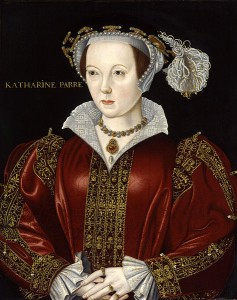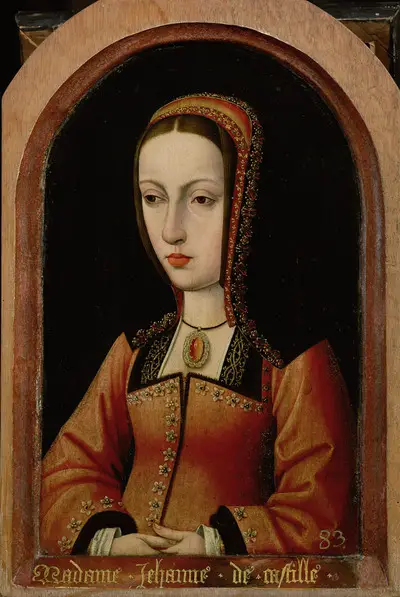Over to Roland...
When Henry VIII married Katharine Parr in 1543, the general opinion was that the King had chosen most wisely. Unlike his previous wife, Katheryn Howard, this Katharine was no young lady with a sordid past, but a mature, sensible widow. The new Queen was also known for her piety.
While Katharine's devoutness should have been applauded by all, her inclination towards the new Protestant faith was an irritant to conservatives, principally the Bishop of Winchester, Stephen Gardiner. Appalled by what he perceived as the spreading of heresy at Court, Gardiner was determined to bring down Katharine Parr and her circle of like-minded friends. His plan would involve a remarkable woman by the name of Anne Askew.
Anne Askew was born in 1521 to a family of ‘a very ancient and noble stock’ in Lincolnshire. The Askews were so highly respected that the wealthy Kyme family was most eager to make a marriage alliance between them. The Kyme heir, Thomas, was betrothed to Anne’s elder sister until tragedy struck when the girl died unexpectedly. Rather than forego such a prosperous match with the Kymes, the Askews had Anne take her sister’s place.
Even with the ‘great wealth and prosperity’ that she had entered into, Anne found married life with Thomas Kyme miserable and unfulfilling. She dutifully bore him with two children, but even motherhood failed to provide her with any true measure of happiness. Her yearnings were fulfilled when at some point in her marriage, Anne became enraptured by the new faith.
Anne's conversion came about through the introduction of the English Bible. Since 1538, it was ordered that all Justices of the Peace were to ‘cause the Bible and Testament in English to be held in their shires,’ and the people allowed access to it. It was such a copy in the Kyme’s parish church that Anne took up reading. As she spent hours on end studying, memorising, and interpreting the Bible, Anne found that she could no longer accept the traditional Catholic teachings that she had been brought up in. Like many an enthusiastic convert, Anne made no secret of her new beliefs, and she very publicly gave voice to her religious convictions. She was as quick to extol the righteousness of the new faith, as she was to condemn the old. In no time, Mistress Askew’s outspokenness and her piety drew the attention of the community.
Her husband, Thomas Kyme, however, remained firmly fixed in the faith of his ancestors. Anne had made a spectacle of herself in defying these ways, and she had made him a laughing stock as a man who could not control his own wife. Any verbal argument was useless against the stubborn and more intelligent Anne, and Kyme resorted to beating her. Matters came to a head when upon the advice of local clergymen, the fed up Kyme ‘violently drove her’ from their house.
The only regret Anne probably had was the loss of her children, but her expulsion for her home was read as a godsend. She was now freed from her dreary existence as Thomas Kyme's wife; a relationship that even she no longer considered held any validity, legal or otherwise. From Anne’s point of view, Kyme had so cruelly cast her out thus violating the sanctity of their union as ordained by God, the ‘chief author of marriage.’ Taking the words of Saint Paul to heart that ‘if a faithful woman have an unbelieving husband, which will not tarry with her, she may leave him’, Anne did just that. Since she and Thomas Kyme were religiously incompatible (he being in the wrong of course), and that it was her husband who instigated their estrangement by tossing her out, Anne felt justified in setting out to London to obtain a divorce.
Anne arrived in London, not as ‘Anne Kyme’ but under her maiden name, which she now referred to herself as for the remainder of her life. Soon she became part of a network of Reformers, gaining renown for herself for her ‘gospelling.’ In no time, Anne’s piety was as much spoken of London as it was in Lincolnshire. She was also said to have been involved in the distribution of Protestant literature and to have sent books to Katharine Parr herself. Her actual association with the Queen, whether in person or through books is murky, though Anne apparently did attract the attention of some of Katharine’s ladies who provided her with financial assistance.Her celebrity was to land Anne in prison for heresy in March 1545. She was hauled before a quest (a commission empowered to investigate heresy) for speaking against the Eucharist. Anne’s clever and evasive answers, in combination with her superior knowledge of the Bible, wore out her investigator who called for a priest to take over the questioning. Anne's new interrogator asked her point blank as to her opinion of the Sacrament of the Altar. Knowing him ‘to be a papist,’ she refused to answer. But as to the priest's inquiry as to the importance of Masses for the dead, Anne could not help but say that it was a ‘great idolatry’ to believe in them rather than in Christ Himself.
The Lord Mayor was then summoned to see what he could do with Anne. A short tempered and intimidating grandee, he berated her as a ‘foolish woman’. Playing the theologian, he demanded of Anne whether a mouse, nibbling on the Eucharist, could receive God? Anne said nothing, but simply smiled - “a woman of few words is the gift of God,” Anne later remarked.
The Bishop's chancellor who sat in on the examination, then angrily reprimanded her for ‘uttering the Scriptures’ as it was forbidden by Saint Paul for women to do so. To this, Anne replied she knew as much as the chancellor, and even corrected him. Saint Paul, she explained, meant that women could not teach or expound Scripture in public. Then with a hint of mockery, Anne asked him how many women had he ever seen go onto the ‘pulpit and preach?’ None, he mumbled, giving into Anne. Seeing that all this questioning proved fruitless, the Mayor put Anne back into custody.
In June, she was hauled before a body far worse than the quest - the King's Council. The interrogation began on the subject of her estrangement from Thomas Kyme, who was also summoned to appear. The Council found ‘no honest allegation’ supporting her reasoning why she ought to be separated from her husband. Kyme was allowed to go, but Anne was subjected to more examination by Bishop Gardiner, her ‘Judas’, as Anne called him to his face. Anne was to account for her beliefs, specifically on the Real Presence again. As she usually did, Anne answered in riddles and parables. She offered to give plain answers if she was permitted to speak directly to the King in person. This bold request was of course denied.
For refusing to recant, Anne was tried for heresy at London’s Guildhall. She stuck by her truth, and loudly denounced the belief of Christ's presence in the Eucharist “As for that ye call your God, it is a piece of bread… let it but lie in the box three months,” she shouted, “and it will be mouldy, and so turn to nothing that is good. Whereupon, I am persuaded that it cannot be God!” The outcome of her trial surprised no one, not even Anne herself. She was sentenced to death by burning as a heretic.
Anne's condemnation did not put an end to efforts to make her recant. Nicholas Shaxton, the former Bishop of Salisbury who was condemned with her for heretical opinions at the Guildhall, but afterwards saved by reverting to his former faith, was brought in to convince Anne of her errors. She had nothing but contempt for Shaxton, and dismissed him from her presence, saying it would have been ‘good for him never to have been born.’ Anne’s refusal to submit rendered her only useful as an example to other heretics when she was to go to the flames, but perhaps, it was proposed by Gardiner, she could also be useful for other means. It was rumoured that Mistress Askew had high-placed friends, including Queen Katharine herself. Could Anne, the Bishop wondered, be the key to getting rid of her?
With the connivance of Sir Thomas Wriothesley and Sir Richard Rich, Anne was secretly taken from her prison to the Tower of London. There was no attempt or interest in turning her anymore, and her interrogators demanded the names of her friends at Court. Anne was then put to torture, despite the protests of the Lieutenant of the Tower. Determined to wring out a statement from their prisoner, Wriothesley and Rich began racking Anne themselves until she was ‘nigh dead.’ But still she would name no names. Exhausted and exasperated by her silence, Rich and Wriothesley had Anne returned to her prison.On 16 July, Anne, her body broken by torture, was carried in a chair to Smithfield, along with three others sentenced to die with her. None of her friends at Court dared to speak up for Anne. But it did not matter. Anne had always known the price of her defiance. She had endured unbearable adversity for the glory of God, and now the flames, always inevitable, were welcome.
Near Saint Bartholomew's Church, a great pyre was set up surrounded by thousands of onlookers come to witness the grisly spectacle. There, Anne was pulled off her chair, and tied to one of the stakes with a chain. Bags of gunpowder were attached to each of the condemned, hopefully to explode, killing them instantly before the pain of the fire became too great. Before the wood beneath them was put to the torch, Anne’s old tormentor, Thomas Wriothesley, offered her and her companions a last pardon in the King's name if they would finally recant. They all refused. Not even the sight of the rescued Bishop Shaxton, who preached at their burning, could shake their resolve. With that, the pyre was lit.
As the fire lapped up towards their feet, it began to rain slightly, and a crackle of thunder was heard. It was noticed that the sky above Smithfield changed colour. In an age when miracles and portents were readily accepted, Anne's supporters viewed this as a sign. The heavens had opened up to receive these blessed martyrs, they said, and to proclaim the ‘high displeasure of God for so tyrannous a murder of innocents.’
You can catch up with Roland's other book tour stops by using the information on this schedule:
The Turbulent Crown: The Story of the Tudor Queens
 Ten remarkable women.
Ten remarkable women.
One remarkable era.
In the Tudor period, 1485–1603, a host of fascinating women sat on the English throne. The dramatic events of their lives are told in The Turbulent Crown: The Story of the Tudor Queens of England.
The Turbulent Crown begins with the story of Elizabeth of York, who survived conspiracy, murder, and dishonour to become the first Tudor Queen, bringing peace and order to England after years of civil war. From there, the reader is taken through the parade of Henry VIII’s six wives - two of whom, Anne Boleyn and Katheryn Howard, would lose their heads against a backdrop of intrigue and scandal.
The Turbulent Crown continues with the tragedy of Lady Jane Grey, the teenager who ruled for nine days until overthrown by her cousin Mary Tudor. But Mary’s reign, which began in triumph, ended in disaster, leading to the emergence of her sister, Elizabeth I, as the greatest of her family and of England’s monarchs.
Paperback: 552 pages
Publisher: MadeGlobal Publishing; 1 edition (January 11, 2017)
Language: English
ISBN-10: 849459379X
ISBN-13: 978-8494593796
ASIN (kindle): B01N6PJJJV
Go to http://getbook.at/turbulentcrown to find out more on your country's Amazon store.
Roland Hui received his degree in Art History from Concordia University in Canada. After completing his studies, he went on to work in Interpretive Media for California State Parks, The U.S. Forest Service, and The National Park Service.
Roland has written for Renaissance Magazine and for Tudor Life Magazine. He blogs about 16th-century English art and personalities at Tudor Faces at: tudorfaces.blogspot.com.







Turbulent life?
Well, all of Henry VIIII’s wives… trying to survive his wobbly moods…
Anne Boleyn had the most turbulent reign.🌹 🗡 ⚰️ 🥀
Anne Boleyn!
Looks like a book I want to read
I think Katherine of Aragon had the most turbulent life. Sent to England to become queen, then widowed, forced to spend years nearly destitute. Finally becoming queen again, yes she enjoyed many years of happiness with Henry, marred by the sadness of losing all but one of her children. Then cast aside for a younger woman, separated from her daughter only to die alone and poor. Tragic.
I would say Katherine of Aragon (or as I like to call her, Catalina) had the most turbulent life. To endure all of the tragic losses of her children through no fault of her own and still manage to keep Henry’s love for over 20 years is a testament to her love for Henry and managing his moods, shows her intelligence in holding onto her faith and love and overcoming challenging times.
Anne Boleyn. Years of being courted by the King and waiting for marriage followed by the constant pressure to bear him a son. Then dealing with his affairs and always feeling vulnerable and aware of the dislike of the English people. Finally all the events of her arrest and imprisonment and execution
Katherine of Aragon I agree with Cathy and Lynsey. Her life was turbulent and with all Katherine had to endure from Henry and others she maintained her dignity until the end of her life. She was a true Queen.
I find the women of the tudor period as fascinating as HenryVIII himself. I Look forward to reading this book.
I think that Katherine of Aragon suffered the most in her tumultuous years of marriage to Henry VIII. The legitimacy of her marriage to him was questioned after so many years and then to have a much younger woman come along to capture her husband’s eye and his heart must have been a trial few would endure with the grace that she did. Anne Boleyn’s life was certainly not easy, but Katherine’s suffering was so prolonged since she lived much longer.
Anne Askew led a turbulent life, but she also broke free and chose to declare her beliefs to the world. Her story and suffering has been told by others who held her as a heroine and martyr. A proper modern study is overdue. I would love to read further. Thanks.